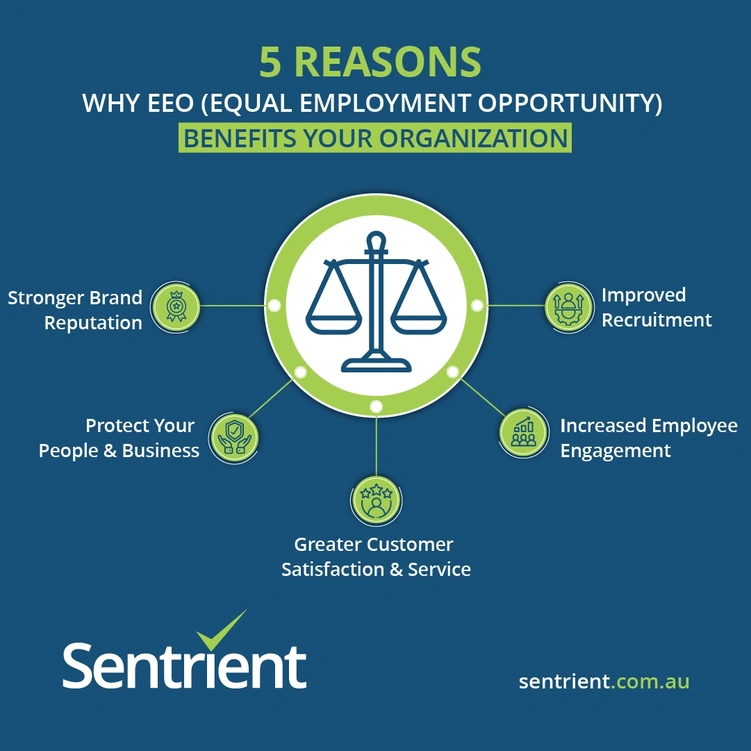We all thrive in a workplace that we love to come back to every day. It is also becoming more commonly recognised that an organisation that embraces Equal Employment Opportunity and advocates for workers’ safety are sure to win the confidence and trust of their people. Furthermore, it is essential that an organisation enforces and acts on laws to safeguard the identity of, respect their people, and protect them from any unlawful undertaking whatsoever. However, the importance and benefits of imposing Equal Employment Opportunity training and policies are not limited to the employees. It has a broad scope of recognition for the employer as well. Please read on to find out why understanding and implementing best practice EEO is vital for your organisation.

Improved recruitment
Since it is a requirement enforced by the law to consider all applications equally regardless of their background, race, culture, religion, language, etc., the organisation can focus on evaluating the talent, skill set, and abilities of applicants who can efficiently contribute and make significant value-addition to the organisation. Usually, most organisations overlook the demand of the vacant position and fail to recruit the right candidate by hiring an individual who seemingly fits the role without any evaluation or assessments done to measure one’s qualifications. Hence, on the lines of the Equal Employment Opportunity policy, the companies can spread word of mouth of their transparent and ethical recruitment process, attract potential applicants make unbiased hiring decisions to employ qualified candidates, and build a proficient team with the right know-how and capacity to perform challenging tasks to add to the overall growth of the organization.
Increased employee engagement
The Equal Employment Opportunity policies allow employees to interact openly and engage with each other without discriminating against peers based on their race, sex, religion, or hierarchical rank in the organisation. It not only promotes respect toward fellow employees but also breeds an open, friendly culture with an opportunity to help and encourage co-worker performance and add up to diversity in the organisation. Such policies, when implemented, create a healthy environment for the employees to quickly reach out to their subordinates as well as higher authorities and build an effective, transparent communication system within the organisation that scales up their productivity and broadens the scope of knowledge exchange.
Greater customer satisfaction and service
Customers and stakeholders hold the firm assurance of the organisation that if its employees perform well, they will contribute to the success of the organisation as it imposes sound guidelines to ensure a safe and hospitable workplace for everyone. A work environment that is conducive to the all-round development of employees aids encouragement in them to work more efficiently, achieve more milestones in a short time, and produce excellent results that ultimately lead to serving customers with improved services, thereby increasing client retention and satisfaction.
Protect your people and your business
The Equal Employment Opportunity policy draws a baseline for employees to be aware of acceptable behaviour, which is critical considering the varying differences in lifestyles, attitudes, values, and socioeconomic strata. It helps employees feel secure and that they’re being treated equally and fairly, increasing their level of dedication, loyalty, and satisfaction toward the employer. Employers who issue robust and comprehensive EEO policies, as well as educate their staff through training on EEO, can create an efficient system to mitigate legal liabilities associated with unlawful behaviour, derogatory remarks or acts, and unequal employment practices and take anticipatory measures to protect individuals and their rights. The critical thing is that if discrimination takes place or is perceived to have taken place at work, our people know how to identify, report and resolve such issues. Also, it enables employees to raise allegations against disparate treatment, while the employer must take legal, fair and ethical actions to restrain further workplace conflict.
Stronger brand reputation
Employees prefer working for organisations regarded well in the industry owing to their strong adherence to Equal Employment Opportunity policies. The policies can either make or break the image of an organisation. However, if implemented effectively, the EEO policies add to the brand recognition of an organisation based on its actions toward its commitment to fair and equal workforce conduct. It not only uplifts employee morale but also makes significant differences in profitability and productivity, thereby increasing the total revenue. These policies have a positive impact on corporate stock value as they moderate the cost associated with lower morale and revenue.
The Final Word
There’s no doubt as to why organisations should issue Equal Employment Opportunity policies. However, in devising and implementing one, companies should educate and train their workforce about the growing incidents of workplace conflict due to prejudices based on background, race, sex, culture, religion, language, etc., and how they can identify, report and resolve such incidents in the workplace. It is the responsibility of an organisation to strive for a safe, fair and inclusive work environment for their workers where they can prosper and contribute intrinsically to the organisation’s growth. That is why we see an increase in commitment from organisations of all sizes, from small and medium businesses to larger organisations, to train their staff and have policies in place for things such as work health and safety, privacy, workplace bullying, sexual harassment and equal employment opportunity. That is because we now recognise the importance of both physical security and social protection for our people.
Read More About Equal Employment Opportunity:
- How Does Equal Employment Opportunity (EEO) Affect The Workplace?
- Why Is It Important To Have Equal Opportunities In The Workplace?
- Disability is a Personal Attribute Protected by Law
- Learn How Age is a Personal Attribute Protected by Law for Providing EEO
- What Is Equal Employment Opportunity and The Personal Attributes Protected By It?





